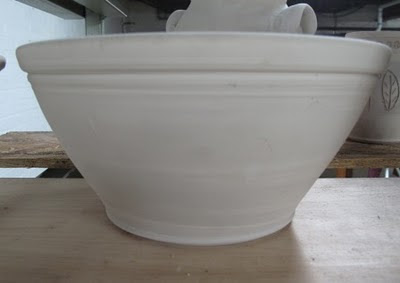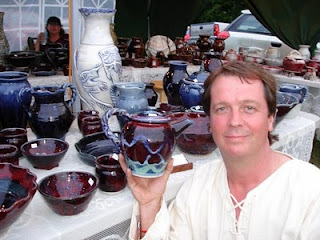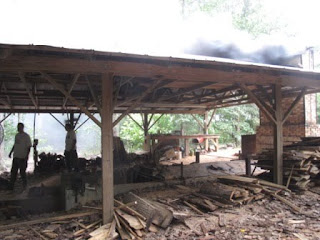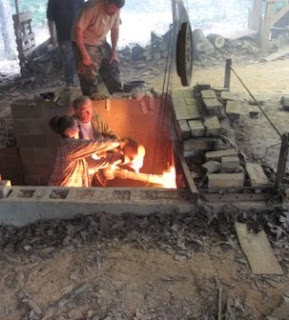I've been trying some new rim styles, and looking more closely at how my rims have evolved over the years. As an apprentice at Berea College in the Ceramics Apprenticeship Program I remember often taking a mug in the green state, and putting it to my lips to decide how it felt. I've continued to use this method, but have also been critiquing my past work and the rims of cups and mugs which have made their way into my cupboards. So I wanted to post some thoughts and photos to see what other people and potters thought!
The slightly flared rim:
This style of rim has been my usual go-to rim for a long while. However, I've found that the thinness that this rim tends to take lends it to chipping. Mugs with this rim that I made several years ago now have chips on the rims. I am not satisfied with a thicker, slightly flared rim as I find that liquids tend to dribble more with a thicker, rounded rim.
 |
| Slightly flared and thinner on the left, thicker, slightly flared on the right. Both of these mugs were made by me 2+ years ago. |
The inverted rim:
I am not often attracted to an inverted rim. I think it feels and looks awkward, and unless it is accompanied by a straight outer edge, I do not personally find an inverted rim functional. A man once said to me at a show that he preferred a rim which dips in so it doesn't spill out all over him. I have an aversion to this type of rim usually because I (with my wild imagination) picture the liquid in the mug being held back only slightly behind this inverted rim, and then jumping over the edge and attacking my lips.
 |
| Mug made by Karin Solberg, current resident potter at Berea College. This is a rare case of an inverted rim in my cupboard! |
The thicker rim with some transition at the top:
This has become my happy medium. A slightly heavier rim (also because I have been focusing on wood kiln firing) with a straight outer edge, and the interior transitioning to a rounded peak at the top of the piece. It feels good on the lips, doesn't seem to cause much dribbling on the side, and withstands a good knocking about and intense firing.
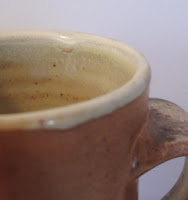 |
| Mug made by Jim Dugan |
 |
| My new developing rim |
Historical contemplations:
I've also been thinking about how rims on mugs, cups, and tankards developed historically. Did potters sit around in their factories judging other potter's forms, testing them out? I can hear them (in a good, thick English accent),"Gee, John, that rim just does not feel right nor speak to me in a proper manner, perhaps we should go back to the wheel and adjust it." I doubt it. It started with the design patterns created for the proprietors of the pottery factory (I'm speaking more in terms of English pottery as I am more familiar with the entirety of that process and have seen more design books, molds, etc. for this type).
So a separate individual from the potters drew the designs for the wares, often specifying the dimensions and the details. Where did the critique and assessment of the pieces take place? I cannot say I have read nor heard of wares being pulled off of the line after being thrown (for those that know this better than I, please correct me!). In a factory setting, no one was paid until the wares were out of the final glost (glaze) firing, and really only assessed for flaws, not function or aesthetics.
Rims from various stoneware vessels vary in style, shape, and size. The fragility of white salt-glazed stoneware accompanies the often narrow, sometimes overly-flared rims. It is no surprise to me that the hollow ware forms in white salt-glazed stoneware do no survive as well as other heavier stoneware vessels. I know that it was meant to be more refined, but I do wonder what the consumer/user thought of this rim as they used it for tea, etc.
 |
| White stoneware from the Pottery With a Past: Stoneware in Early America exhibit at Colonial Williamsburg, Fall 2009. |
English brown stoneware rims are all over the place. They vary from thick, rounded rims to very thin. I enjoy the thinner rims much more, but have seen many surviving pieces with severe chips and cracks on the rims, which is not a terrible surprise. One thing that I admire the most about English brown stoneware are the small linear patterns and lines which are usually found just below the rim.
 |
| Brown English stoneware from from the Pottery With a Past: Stoneware in Early America exhibit at Colonial Williamsburg, Fall 2009 |
German stoneware rims always seem a little more beefy and thick. This would definitely stand up to heavy use and transportation. I have yet to put my lips to the edge of a thick German ware or to test it out and see whether it dribbles. Maybe someday!
 |
| German stone from from the Pottery With a Past: Stoneware in Early America exhibit at Colonial Williamsburg, Fall 2009 |
So, in closing, should there really be consistency? Or is this the case of "to each his own?"

